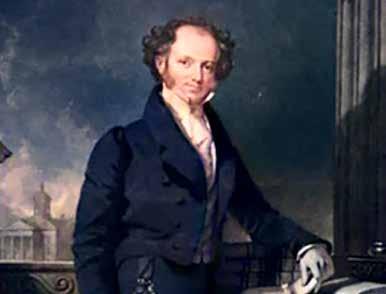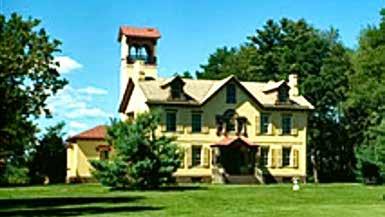
5 minute read
A President’s Day Look at Martin Van Buren
by Joseph Raucci for Saratoga TODAY
This coming Monday we celebrate Presidents’ Day. The Federal holiday honors the 45 men who have attained the Office of The Presidency of the United States. It’s an ideal time to look at the remarkable life of Martin Van Buren. He was our eighth President and the first of six New York State residents to hold the office.
THE BEGINNINGS
Martin Van Buren’s life’s journey began less than 60 miles from here in Kinderhook, New York. The region, including Albany had been settled by immigrants from the Netherlands a century and a half before Martin was born. His date of birth was December 5, 1782. He was brought up in a home that spoke Dutch as its primary language. It would give him the distinction of being our only President to speak English as his second language.
Martin took a well travelled road to the political arena. He learned the law beginning at the age of 14 as a clerk at an attorney’s office. Seven years into his apprenticeship he passed the bar. The year was 1803. Martin Van Buren at the young age of 21 was on his way.


THE ASCENT TO POWER
Van Buren became known for his sharp mind and dapper attire. Soon he was considered one of upstate New York’s best courtroom attorneys. This distinction gave him a heads up for the nomination as a candidate for the State Senate in 1812. Although barely elected to the seat, Van Buren soon became a force to be reckoned with in the hotbed of New York State politics.
Five years later the Dutchman was elected Attorney General of The Empire State. In that post he became a leader of the state’s Democrat-Republicans, the forerunner of the Democratic Party.
In 1821 he was chosen by his peers as a United State senator. Of note, prior to the seventeenth amendment to the Constitution ratified in 1913, senators were voted in by their state legislatures. The senate seat gave Van Buren the keys to New York State’s thriving political machine. Although he was out of the state for long periods of time, he formed a group of partisans that controlled the spoils system in his absence. They became known as “The Albany Regency.”
It was in that time period Van Buren was labeled with a pair of nicknames that stayed with him throughout his career. He was called “The Little Magician” and “The Sly Fox.” The former was a reference to his diminutive size and unmatched political skills, the latter due to the red color of his hair and shrewd methods of governing.
Van Buren made his greatest political gift to the country in the early 1820s. He was instrumental in forming the Democratic Party. It was the beginning of our two party system. The long lasting effects are still in place almost two centuries later.
The 1828 presidential election was a turning point in Van Buren’s political career. He gave his unwavering support to the winning candidate, Andrew Jackson. In that same cycle Van Buren was elected as Governor of New York. His term began on January first, 1829. On March fourth Jackson became President. One of his first priorities was to name Van Buren as Secretary of State. He accepted the position after serving only 64 days as Governor. He quickly became a major player in international affairs. Later in Jackson’s first term, Van Buren served for a short time as Minister to Great Britain. Jackson ran for a second term in 1832. Van Buren was his handpicked choice for number two man on the ticket. They easily won the election. “The Little Magician” spent the next four years as Vice-President. With Jackson’s blessing, Van Buren became the unanimous choice as the Democratic Party’s candidate for President in 1836. He won the general election with ease. Much was expected from the wily politician when he was sworn in as our eighth President. It was his ill fortune to be confronted with the country’s first major depression only a few weeks into his administration. Van Buren would struggle with the calamity for his entire time in office. The old nicknames of respect were replaced by a new one.” Martin Van Ruin” became the rallying cry of his adversaries. There were positive results in his tenure, unfortunately not enough to halt the Nation’s financial crisis. The bright star of Martin Van Buren was quickly fading.
A President’s Day Look at Martin Van Buren
continued from page 2...
After four years in the White House he was soundly defeated in his re- election bid. He had this to say about his tenure as Chief Executive.
“As to the Presidency, the two happiest days of my life were those of my entry upon the office and my surrender of it.” He promptly exited Washington,D.C. and headed home to Lindenwald, his estate in Kinderhook.
His term as President is hard to gauge. Being saddled with a nationwide financial disaster is a difficult, if not impossible obstacle for any leader to overcome. Though eminently qualified for the office, Herbert Hoover would learn the same lesson nearly a century later. As for Van Buren’s political skills as President, he is without peer.
THE LINDENWALD YEARS
Lindenwald was purchased by Van Buren in 1839. It is located in his hometown of Kinderhook. The estate covered over 200 acres at the time and was also a working farm. The centerpiece of the property is a Georgian Style Mansion that Van Buren transformed into his vision of an Italian Villa.
The former President relished in his new surroundings. Here is a quote from Van Buren describing how he felt about his years at Lindenwald. He stated “The last and happiest days of my life, a farmer in my native town.”
Van Buren spent much of his last years traveling and was in high demand as a speaker at important events. He did make an attempt to regain the Presidency as a failed third party candidate in 1848. He also found the time to write a lengthy volume of memoirs. Martin Van Buren, “The Red Fox of Kinderhook” passed away on July 24th 1862. He was 79 years old.
Lindenwald is now a National Historical Site. Tours are given daily throughout most of the year, excluding the winter months. The home has been refurbished to the time of Van Buren’s occupancy. Many of his belongings and period furniture decorate the interior of the mansion. It’s about an hour’s drive from here and a worthwhile day trip for those who have an interest in the history of both our state and country.
A TRIP TO SARATOGA
Van Buren visited Saratoga Springs during his presidency. In the summer of 1839 he attended political meetings at the original United States Hotel on Broadway. It is not to be confused with its famous namesake that was built on the same site after an 1865 fire destroyed the original building.
Van Buren is one of several of our Presidents to have spent time here. George Washington, Franklin D. Roosevelt, Ulysses S. Grant, and Theodore Roosevelt are among those who also visited the city.
I hope you have enjoyed our look back at the life and times of Martin Van Buren. He is one of the select few who have guided this great country through the nearly two and a half centuries of its rise from a newborn nation to its status as leader of the free world.
VISITING LINDENWALD
The following is a link to the Martin Van Buren National Historic Site: www.nps.gov/nr/ travel/presidents/van_buren_ lindenwald.html






